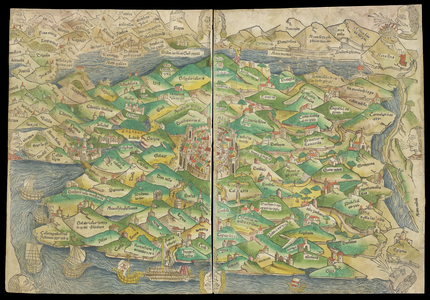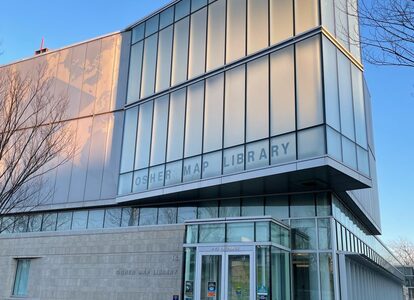Osher Map Library at USM
BackOsher Map Library at USM
314 Forest Avenue
The Osher Map Library and Smith Center for Cartographic Education is housed on the ground floor of the USM Library building.
With nearly half a million cartographic items, this map library holds one of the finest collections of maps anywhere in the U.S. The library and its exhibits are free, open to the public, and well worth a visit – but do make an online reservation ahead of time. There is ample public parking.
One of the library’s unique treasures is a 1475 map of Palestine—what is understood to be the first modern printed map in existence anywhere. This map of the Holy Land is considered “modern” because it’s not derived from a classical source (like Ptolemy), nor is it in the circular schematic format characteristic of medieval maps. However, it retains two “premodern” attributes: it is oriented with east at the top, and Jerusalem at the center, represented as a circular walled city overlooked by the Mount of Olives. This map presents a bird’s-eye view of cities and regions as hills, as well as some crudely illustrated biblical scenes (at the upper right corner, Moses receives the tablets on Mount Sinai; at the upper center, the baptism of Jesus).
The Osher Map Library was founded by Harold and Peggy Liberman Osher and Lawrence and Eleanor Houston Smith. Harold Osher (1924-2023) was born in Portland to parents who immigrated to Maine from Lithuania and Russia. Harold and his siblings grew up in Biddeford and worked with their parents at their hardware business, but he ended up attending Bowdoin College and then medical school at Boston University. Harold and Peggy (1929-1918) married in 1950 and moved to Maine to raise their family. During his 45 years of practice, Dr. Osher contributed to the growth of Maine Medical Center and its division of cardiology, where he served as director. He also had faculty appointments to the schools of medicine at Boston University, Tufts University and the University of Vermont.
Towards the end of his medical career, Harold and Peggy visited London and became fascinated by an exhibition of early maps at the British Library. They explored several nearby map shops, and Peggy suggested that Harold buy a few antique maps to bring home. These maps grew into a major collection that was gifted to USM in 1989. It includes two Yiddish maps of America, each of which spell “Maine” differently, as there is no standardized way to transliterate English into Yiddish.

